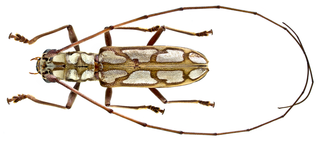
In Christian liturgy, "the Pax" is an abbreviation of the Latin salutations "pax vobis" or "pax vobiscum", which are used in the Catholic Mass and Lutheran Divine Service.
Dixit Dominus is a psalm setting by George Frideric Handel. It uses the Latin text of Psalm 110, which begins with the words Dixit Dominus.

Olenecamptus is a genus of longhorn beetles of the subfamily Lamiinae.
Olenecamptus malayensis is a species of beetle in the family Cerambycidae. It was described by Dillon and Dillon in 1948.

Olenecamptus quadriplagiatus is a species of beetle in the family Cerambycidae. It was described by Dillon and Dillon in 1948. It is known from Vietnam.
Olenecamptus indicus is a species of beetle in the family Cerambycidae. The species was first described by Stephan von Breuning in 1936, originally under the genus Cylindrepomus. They have since been reclassified as part of the Olenecamptus genus.
Olenecamptus pseudostrigosus is a species of beetle in the family Cerambycidae. It was described by Stephan von Breuning in 1938.
Olenecamptus formosanus is a species of beetle in the family Cerambycidae. It was described by Maurice Pic in 1914. It contains the varietas Olenecamptus formosanus var. decemmaculatus. It occurs in East Asia.

Olenecamptus optatus is a species of beetle in the family Cerambycidae. It was described by Pascoe in 1866. It is known from Thailand, Singapore, Malaysia, Sumatra, Vietnam.
Olenecamptus strigosus is a species of beetle in the family Cerambycidae. It was described by Pascoe in 1866. It is known from Moluccas, Indonesia, and Papua New Guinea.
Olenecamptus vittaticollis is a species of beetle in the family Cerambycidae. It was described by Heller in 1923, originally as a subspecies of Olenecamptus optatus. It is known from the Philippines. It contains the varietas Olenecamptus vittaticollis var. divisus.
Olenecamptus albidus is a species of beetle in the family Cerambycidae. It was described by Karl Jordan in 1894.
Olenecamptus anogeissi is a species of beetle in the family Cerambycidae. It was described by Gardner in 1930. It is known from India.

Olenecamptus bilobus is a species of beetle in the family Cerambycidae. It was described by Johan Christian Fabricius in 1801, originally under the genus Saperda. It is known from Myanmar, India, Papua New Guinea, Indonesia, Laos, Seychelles, Madagascar, Australia, Sri Lanka, Japan, Sumatra, Java, Philippines and Taiwan.
Olenecamptus cretaceus is a species of beetle in the family Cerambycidae. It was described by Henry Walter Bates in 1873.
Olenecamptus detzneri is a species of beetle in the family Cerambycidae. It was described by Kriesche in 1926. It contains the varietas Olenecamptus detzneri var. curvatomaculatus.
Olenecamptus fukutomii is a species of beetle in the family Cerambycidae. It was described by Hasegawa in 2004. It is known from the Bonin Islands in Japan.
Olenecamptus hofmanni is a species of beetle in the family Cerambycidae. It was described by Quedenfeldt in 1882. It is known from Ghana, Cameroon, the Democratic Republic of the Congo, the Republic of the Congo, Tanzania, the Central African Republic, Gabon, Angola, Malawi, the Ivory Coast, South Africa, and Zimbabwe. It contains the varietas Olenecamptus hofmanni var. dimbokro.
Olenecamptus tessellatus is a species of beetle in the family Cerambycidae. It was described by William Lucas Distant in 1898.
Antonio Vivaldi composed several settings of the Dixit Dominus, the Latin version of Psalm 110. They include a setting in ten movements for five soloists, double choir and orchestra, RV 594, another setting in eleven movements for five voices, five-part choir and orchestra, RV 595, and a recently discovered setting in eleven movements for five soloists, choir and orchestra, RV 807, which had been attributed to Baldassare Galuppi. It is said to be one of his "most significant sacred works."




